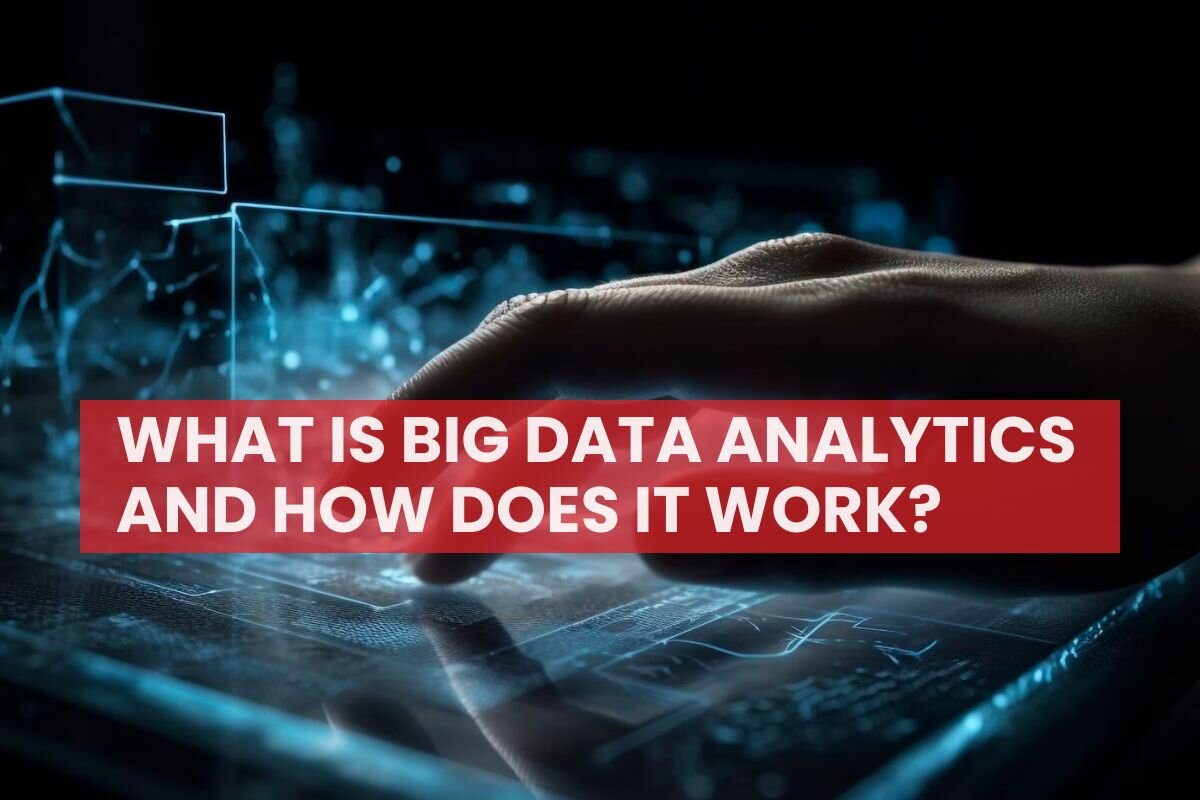Introduction
Big data has become an integral part of our modern world, influencing decision-making processes across various industries. From analyzing consumer behavior to improving business strategies, the utilization of big data has proven to be invaluable. But have you ever wondered how this vast amount of data is collected?
In this article, we will explore the different methods and sources through which big data is collected. By understanding the various data collection techniques, we can gain insights into the massive network that contributes to the development of big data.
The collection of big data involves gathering, storing, and analyzing massive volumes of information from multiple sources. These sources include websites, social media platforms, mobile devices, internet of things (IoT) devices, and many more. Each source offers unique data that, when combined, paints a comprehensive picture of our digital world.
Understanding how big data is collected is crucial for businesses and organizations looking to harness its power. By recognizing the sources and methods of data collection, they can make informed decisions based on accurate insights and trends. So let’s dive into the fascinating world of big data collection!
Websites and Internet-Based Data
Websites are one of the primary sources for collecting big data. Every time we visit a website, our actions and interactions generate data that can be captured and analyzed. This data includes information such as page views, click patterns, user behavior, demographics, and more.
The collection of internet-based data is typically done through various techniques, such as web scraping and tracking technologies. Web scraping involves extracting data from websites using automated bots or software. These bots navigate through web pages, collecting relevant information and storing it in a structured format.
On the other hand, tracking technologies use tools like cookies or pixel tags to monitor user activities on websites. These technologies enable website owners to gather data on visitor behavior, preferences, and interactions. This information can then be analyzed to understand website performance, user preferences, and target specific audiences.
Websites also collect data through user registrations and account creation. When users sign up for a service or create an account on a website, they often provide personal information such as name, email address, age, location, and more. This data can be utilized for targeted marketing, personalization, and improving user experience.
Moreover, websites make use of analytics tools like Google Analytics to track and analyze website traffic, user engagement, and conversion rates. These tools provide valuable insights into website performance, user flow, and audience segmentation.
Overall, websites serve as a treasure trove of data, offering valuable insights into user behavior and preferences. This internet-based data plays a crucial role in understanding customer needs, optimizing websites, and developing effective marketing strategies.
Social Media and User-Generated Content
Social media platforms have revolutionized the way we connect, share, and communicate. Along with personal interactions, social media has also become a rich source of big data. The vast amount of user-generated content on platforms like Facebook, Twitter, Instagram, and LinkedIn provides valuable insights into consumer behavior, preferences, and trends.
Social media platforms collect data through various mechanisms. When users sign up for an account, they provide personal information such as age, gender, location, and interests. Additionally, users willingly share their thoughts, opinions, and reactions through posts, comments, likes, shares, and hashtags. All of this content is valuable for understanding consumer sentiment, identifying influencers, and tracking trends.
Moreover, social media platforms use algorithms to track user activities and behaviors. They analyze user interactions, interests, and engagement patterns to provide personalized content and targeted advertisements. By collecting data on user preferences, platforms can tailor content to match individual interests and increase user engagement.
In addition to the data shared by users, social media platforms also gather information through social listening. This involves monitoring public posts, discussions, and conversations to gain insights into broader trends and sentiments. Social media listening tools enable companies to track mentions of their brand, analyze customer feedback, and identify potential issues or opportunities.
Furthermore, social media platforms offer analytics tools for businesses and marketers. These tools provide detailed metrics and data on post performance, reach, engagement, and demographic information about the audience. Marketers can leverage this data to refine their social media strategies, identify target audiences, and measure the effectiveness of their campaigns.
Overall, social media and user-generated content provide a wealth of data that enables businesses to understand their target audience, engage with customers, and drive marketing initiatives. The insights gained from social media data contribute to the development of effective marketing strategies and the creation of personalized experiences for users.
Mobile Devices and Wearables
Mobile devices have become an indispensable part of our lives, offering convenience and connectivity on the go. These devices, along with wearables like smartwatches and fitness trackers, have become valuable sources of big data. The data collected from mobile devices and wearables provides insights into user behavior, location, health, and more.
One of the primary ways data is collected from mobile devices is through mobile applications. When users download and use apps, they often give permissions for the app to access specific data, such as location, contacts, camera, and microphone. This data can be used to provide personalized services, location-based recommendations, and targeted advertisements.
Moreover, mobile devices and wearables are equipped with sensors that collect data on various aspects. For example, fitness trackers gather information on heart rate, steps taken, calories burned, and sleep patterns. This data provides valuable insights into the user’s health and fitness habits.
Location data is another significant aspect collected from mobile devices. GPS capabilities allow devices to track the user’s location accurately. This information can be used for targeted advertising, location-based services, and understanding consumer behavior based on geographic patterns.
Furthermore, mobile devices and wearables can capture user interactions, such as touch gestures, swipes, and taps. This data can be used to analyze user behavior and improve the user experience of mobile applications and websites.
Data from mobile devices and wearables is often collected in real-time, providing up-to-date and accurate information. This real-time data enables businesses to make informed decisions promptly and adapt their strategies based on the latest trends and user preferences.
Overall, mobile devices and wearables offer a wealth of data that provides insights into user behavior, health, preferences, and location. The data collected from these devices plays a crucial role in understanding consumer needs, personalizing services, and improving the overall user experience.
Internet of Things (IoT) devices
The Internet of Things (IoT) refers to the network of physical devices, vehicles, appliances, and other objects embedded with sensors, software, and connectivity that enable them to collect and exchange data. These IoT devices have become a significant source of big data, providing insights into various aspects of our lives.
IoT devices collect data through sensors that capture information about the environment, usage patterns, and user interactions. For example, smart thermostats collect data on temperature, occupancy, and energy usage to optimize heating and cooling systems. Smart meters collect data on electricity consumption in households, providing valuable insights for energy management and conservation.
Furthermore, IoT devices such as connected cars and fleet management systems gather data on vehicle performance, fuel consumption, and driver behavior. This data is used to enhance safety, improve fuel efficiency, and optimize maintenance schedules.
In addition to individual devices, IoT ecosystems generate data through interconnected systems. For example, in a smart home, various IoT devices like security cameras, door locks, and smart appliances interact and share data. This interconnectedness allows for automation, remote monitoring, and seamless integration of different devices.
The data collected from IoT devices is typically transmitted to cloud platforms for storage, processing, and analysis. Cloud-based platforms offer scalability, security, and advanced analytics capabilities to handle the vast amount of data generated by IoT devices.
One of the significant advantages of IoT data is its real-time nature. IoT devices continually collect and transmit data, enabling businesses to make informed decisions promptly. For example, in industrial settings, IoT devices monitor equipment performance, detect anomalies, and trigger maintenance alerts to minimize downtime and optimize operations.
Overall, IoT devices play a vital role in generating big data by collecting and exchanging data from various sources. The insights gained from IoT data contribute to improving efficiency, reducing costs, and enhancing the user experience in multiple industries, including healthcare, transportation, manufacturing, and smart cities.
Sensors and Surveillance Systems
Sensors and surveillance systems are crucial sources of big data, providing valuable insights into various aspects of our physical surroundings. These technologies play a crucial role in collecting data for security, monitoring, and analysis purposes.
Sensors are devices that detect and respond to physical stimuli. They can be found in various applications, including environmental monitoring, healthcare, transportation, and manufacturing. Sensors collect data on parameters such as temperature, humidity, pressure, motion, and light intensity. This data helps in understanding environmental conditions and optimizing systems.
Surveillance systems, on the other hand, use a combination of sensors, cameras, and monitoring tools to capture and record data about people, objects, and activities in a given space. Surveillance systems are commonly used for security purposes in public places, workplaces, and residential areas.
Surveillance systems generate vast amounts of data through continuous monitoring. This data includes video recordings, images, and metadata such as timestamps, location, and event descriptions. Analyzing surveillance data can provide insights into crowd behavior, traffic patterns, safety risks, and even aid in solving crimes.
Furthermore, sensors and surveillance systems are often integrated into smart city initiatives. In smart cities, sensors are deployed across the urban landscape to monitor air quality, traffic flow, parking availability, and more. The data collected from these sensors helps in optimizing city services, reducing environmental impact, and enhancing the quality of life for residents.
Data from sensors and surveillance systems are typically stored and analyzed in centralized platforms. Advanced analytics techniques are used to process the data, extract meaningful patterns and trends, and provide actionable insights.
While sensors and surveillance systems provide valuable data, it is essential to handle this data responsibly and address potential privacy concerns. Ensuring proper data governance, anonymization techniques, and compliance with privacy regulations is necessary to protect individuals’ rights and maintain trust in the use of sensor and surveillance data.
In summary, sensors and surveillance systems contribute significantly to the collection of big data by capturing and recording data from the physical environment. This data can be used to optimize systems, improve safety and security, and make informed decisions for various applications and industries.
Government Sources and Public Records
Government sources and public records serve as valuable repositories of big data, offering a wealth of information on demographics, socio-economic trends, public health, and more. These sources provide a crucial foundation for research, analysis, and decision-making in various fields.
Government agencies collect and maintain data on a wide range of topics, including census data, employment statistics, education records, crime rates, and public health indicators. This data is collected through surveys, administrative records, and other data collection methods.
Census data, for example, provides detailed information about population characteristics, such as age, gender, ethnicity, and household composition. This data is invaluable for demographic analysis, urban planning, and resource allocation.
Public health agencies collect and analyze data on disease outbreaks, vaccination rates, healthcare utilization, and morbidity and mortality statistics. This data helps in understanding public health trends, identifying risk factors, and developing targeted interventions.
Government sources also provide data on economic indicators, including GDP growth, inflation rates, unemployment figures, and trade statistics. This data enables economists, policymakers, and businesses to monitor and analyze the state of the economy.
In addition to government agencies, public records play a significant role in providing big data. Public records include documents such as property records, court filings, business registrations, and marriage and birth certificates. These records contain valuable information for legal, research, and investigative purposes.
Government sources and public records are often freely accessible, promoting transparency and facilitating research and analysis. However, due to the sensitive nature of some data, privacy laws and regulations govern the access and use of certain information.
Open data initiatives by governments have also made a vast amount of data available to the public. Open data portals provide access to datasets on various topics, enabling researchers, developers, and businesses to explore and utilize the data for innovative applications.
Overall, government sources and public records serve as vital sources of big data, providing a comprehensive view of various aspects of society. The data collected and maintained by government agencies and public records contribute to research, decision-making, and the development of policies and services that impact our everyday lives.
Market Research and Surveys
Market research and surveys are important methods used to collect big data and gain insights into consumer preferences, behavior, and market trends. These techniques involve gathering data directly from individuals and businesses through various survey methods.
Market research involves analyzing market conditions, customer behavior, and competitor analysis. It helps businesses understand consumer demands, identify potential target markets, and make informed decisions regarding product development, pricing, and marketing strategies.
Surveys are a common tool used in market research to collect data. Surveys can be conducted through different channels, including online questionnaires, telephone interviews, mailed questionnaires, and in-person interviews. They allow researchers to collect quantitative and qualitative data on consumer opinions, preferences, and experiences.
Online surveys have gained popularity due to their ease of distribution, cost-effectiveness, and ability to reach a wide audience. Online survey platforms enable businesses to design surveys, distribute them to targeted respondents, and collect and analyze the data efficiently.
Market research firms often leverage data from their own surveys as well as public opinion polls conducted by various organizations. Data from these surveys can include demographic information, purchasing behavior, brand perceptions, and satisfaction levels.
Additionally, social and behavioral research surveys collect data on societal trends, attitudes, and behaviors. Examples include surveys on lifestyle choices, voting intentions, or attitudes towards certain social issues.
Big data from market research and surveys can be used to identify emerging trends, assess customer satisfaction, evaluate the effectiveness of marketing campaigns, and guide product development. It can also be combined with other data sources, such as social media data or transactional data, to gain deeper insights.
In recent years, the use of online consumer panels and data analytics tools has expanded market research capabilities. These panels allow researchers to gather data from specific target groups and analyze it in real-time. Advanced analytics techniques, such as cluster analysis and sentiment analysis, are used to identify patterns, segments, and sentiment towards products or brands.
Overall, market research and surveys provide valuable big data that helps businesses understand customers, fine-tune marketing strategies, and adapt to changing market dynamics. The insights gained from market research contribute to making informed decisions and staying competitive in today’s fast-paced business environment.
Retail and E-commerce
Retail and e-commerce industries are rich sources of big data, providing valuable insights into consumer shopping behavior, preferences, and trends. The advent of digital technology and online shopping platforms has transformed the way businesses collect and analyze data in these sectors.
E-commerce platforms collect vast amounts of data on customer interactions, website traffic, and purchase history. When customers browse products, add items to their carts, and make purchases, data is generated at every step of the process. This data includes information on product preferences, buying patterns, search queries, and customer demographics.
Retailers leverage this data to personalize the customer experience and improve sales. By analyzing customer behavior and purchase history, retailers can recommend relevant products, offer personalized discounts, and provide a seamless shopping experience across various channels.
In addition to individual transactional data, e-commerce platforms also gather data on overall market trends. For example, they might track the popularity of certain products, monitor customer reviews and ratings, and analyze pricing fluctuations in real-time. This data helps businesses identify emerging trends, optimize pricing strategies, and anticipate customer demands.
Physical retail stores have also started incorporating technology to collect data and enhance the customer experience. For instance, retailers implement RFID tags and sensors to track inventory levels, monitor customer footfall, and analyze store layouts. This data allows retailers to optimize inventory management, improve store layouts, and provide a personalized shopping experience.
Data from retail and e-commerce sectors is not limited to transactions or customer interactions. Retailers also collaborate with third-party data providers to gain insights into consumer demographics, interests, and spending habits. This data is often used for targeted advertising, customer segmentation, and market research.
Furthermore, loyalty programs and customer relationship management (CRM) systems provide valuable data on customer preferences and loyalty. Retailers can analyze this data to understand customer purchasing behavior, identify loyal customers, and tailor marketing strategies to enhance customer loyalty.
The analysis of big data in retail and e-commerce is often coupled with techniques like data mining, machine learning, and predictive analytics. These approaches enable businesses to extract meaningful patterns and insights from the vast amount of data available, helping them make data-driven decisions and drive business growth.
Overall, the retail and e-commerce industries generate significant volumes of big data. By harnessing the power of this data, businesses can gain a competitive edge, enhance customer experiences, and drive innovation in the ever-evolving world of retail and e-commerce.
Financial Transactions
Financial transactions are a fundamental source of big data, offering valuable insights into economic trends, consumer spending patterns, and financial behaviors. The digitalization of financial services has exponentially increased the volume and availability of data related to transactions, creating a wealth of information for analysis and decision-making.
Every time a financial transaction takes place, data is generated and stored. This data includes information such as transaction amount, merchant details, time and date, payment method, and customer profile. For example, credit card transactions reveal details about consumer purchasing habits, preferences, and even geographical information.
Financial institutions, such as banks and credit card companies, use transaction data for various purposes. They employ advanced analytics techniques to detect fraud, identify suspicious activities, and protect customers from unauthorized transactions. Transaction data is also used to gain insights into customer behavior, target marketing efforts, and develop personalized financial products and services.
Moreover, financial transaction data is utilized by economists, market researchers, and policymakers to analyze economic trends, monitor the health of specific industries, and measure consumer confidence. The analysis of aggregate transaction data can provide valuable insights into market conditions, spending patterns, and economic fluctuations.
With the advent of online banking and mobile payment solutions, digital platforms have become major generators of financial transaction data. These platforms capture transaction details, messaging information, and customer interactions. This data is used to improve user experiences, streamline processes, and gain insights into customer preferences and financial needs.
The growth of fintech companies and payment processors has further contributed to the availability of transaction data. These companies collect data on various types of financial transactions, including online purchases, peer-to-peer transfers, and mobile payments. This data can be used by businesses to identify emerging customer trends, improve customer segmentation, and develop targeted marketing campaigns.
While the collection and analysis of financial transaction data offer numerous benefits, it is important to prioritize data privacy and security. Financial institutions must adhere to strict regulations to ensure the protection of customer information and maintain consumer trust in the financial system.
In summary, financial transactions generate significant amounts of big data that hold valuable insights into consumer behavior, economic trends, and market dynamics. By analyzing transaction data, businesses and policymakers can make data-driven decisions, improve customer experiences, and drive economic growth.
Conclusion
The collection of big data has become an essential part of various industries, providing valuable insights for businesses, researchers, and policymakers. From websites and social media to mobile devices and wearables, the sources of big data are vast and diverse.
Websites and internet-based data offer insights into user behavior and preferences, while social media and user-generated content provide a wealth of information on consumer sentiment and trends. Mobile devices and wearables capture data on health, location, and user interactions. Internet of Things (IoT) devices, such as sensors, gather data from the physical environment, enabling smarter systems and optimizing operations.
Government sources and public records offer access to demographic, economic, and public health data, which are invaluable for research and decision-making. Market research and surveys provide insights into consumer behavior, preferences, and market trends, while financial transactions generate data that allows for analysis of economic trends and consumer spending patterns.
Collecting and analyzing big data requires advanced technologies and tools, such as data mining, machine learning, and analytics platforms. These techniques enable the extraction of meaningful patterns and insights from the vast amounts of data collected.
It is important to ensure responsible use of big data, respecting privacy regulations and ethical considerations. Protecting customer information and maintaining trust in the data collection and analysis processes is crucial for businesses and organizations.
In conclusion, understanding how big data is collected from various sources provides valuable insights into consumer behavior, market trends, and societal patterns. By harnessing the power of big data, businesses can make informed decisions, develop effective strategies, and drive innovation in today’s data-driven world.

























